Lapiplasty® 3D Bunion Correction
Are Bunions Keeping You From an Active Lifestyle?
At Desert Orthopaedic Center, we know that bunions can be painful and that they can keep you from doing the things you love. That’s why our board-certified, fellowship-trained orthopedic foot and ankle surgeons, Dr. Abdi Raissi and Dr. Troy Watson, offer Lapiplasty 3D Bunion Correction, a new, patented treatment option for bunions.
Many people think that bunions are simply just an overgrowth of bone that just needs to be removed. However, they are actually a complex deformity of the foot caused by an unstable joint, and this deformity needs to be corrected, not just shaved off.
What Is Lapiplasty 3D Bunion Correction?
Unlike traditional treatment options for bunions, Lapiplasty 3D Bunion Correction is a new, patented treatment option for bunions that addresses the bunion at the source of the problem in three dimensions. This procedure not only used advanced fixation technology to keep the correction in place but also allows patients to walk just days after surgery.1
Why Is Traditional Surgery Ineffective?
Traditional bunion surgery uses a two-dimensional approach. In this procedure, the bone is cut in half, and the top part of it is pushed over to reduce the appearance of the bump. This cut and shift of the bone mostly addresses the symptoms of the bunion. It fails to get to the bottom of the problem, which is an unstable joint creating a three-dimensional deformity of the big toe.2 Because it doesn’t solve the underlying cause, most people who undergo traditional bunion surgery have their bunions come back. 3 In fact, one in three patients who undergo traditional bunion surgery is dissatisfied with the results.4
Traditional bunion procedures are ineffective because:
- 87% of bunions are misaligned in three-dimensions2
- 12x likelihood of bunion coming back if the 3D problem is not addressed3
- Up to 70% of bunion patients have their bunions return over time4
Traditional 2D Surgery
Traditional bunion surgery is similar to fixing the Leaning Tower of Pisa by cutting it and shifting it over.
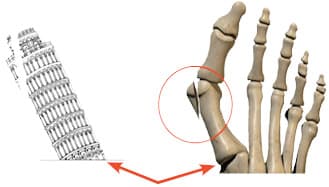
The Bump Is Shaved
Unable Foundation (Source of the Problem Is Not Corrected)
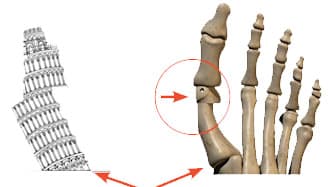
Top of the Bone Is Cut & Shifted Over
Unstable Foundation (Source of the Problem Is Not Corrected)
How Does Lapiplasty 3D Bunion Correction Work?
Unlike tradition bunion surgery where the bone is cut in half and shifted over, the Lapiplasty 3D Bunion Correction procedure uses instruments that have been specifically designed to rotate the bone back to its normal position. This naturally straightens your toe and removes the bump as well as alleviates the pain it has been causing. Using titanium plating technology5.6, the foundation that was once unstable is secured. After the procedure, most patients are able to walk within a few days.1 Since a cast is not needed, they are also able to wear their own shoes and get back to doing the things they love quicker.1
Lapiplasty 3D Bunion Correction Surgery
Lapiplasty 3D Bunion Correction surgery is similar to addressing the underlying cause of the Leaning Tower of Pisa’s problem, the unstable foundation. By rotating the tower back into its original position and securing it, the problem is addressed.

Entire Bone Is Returned to Its Normal Alignment
Unstable Joint
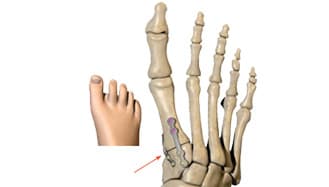
3D Correction Secures the Unstable Foundation Permanently
Joint Is Permanently Secured
What Does a Correction Look Like on X-Ray?
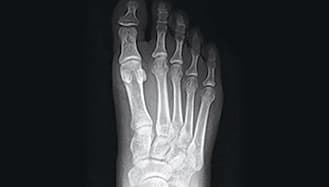
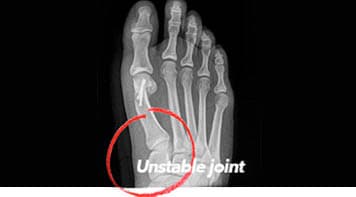
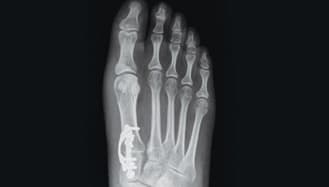
Titanium Plating Technology—Allowing Early Weight-Bearing
Using two small, anatomically-shaped titanium plates, the Lapiplasty 3D Bunion Correction procedure securely stabilizes the once unstable foundation of the bunion. The support this provides on multiple planes allows patients to walk a few days after surgery.1 The procedure uses two plates for a similar reason why a basketball player holds the ball with two hands—it is more secure.
What Should Patients Expect for Recovery?
The procedure and the use of titanium plating technology allow patients the ability to bear weight on the foot early.1 This improves the recovery process, providing patients the ability to walk 6 – 8 weeks faster than those with a Lapidus, a traditional bunion surgery.
Recovery Comparison: Expectations
Lapiplasty 3D Correction
- No casting
- Weight-bearing within days*
- Walking in a surgical boot for 6 weeks
- At 6 – 8 weeks, patients can go back to tennis shoes
- Walking 6 – 8 weeks ahead of the traditional surgery
*Smith B, et al. 2017 AOFAS Annual Meeting, Seattle, WA.
Traditional Lapidus Surgery
- Casting, crutches, scooter
- Non-weight-bearing**
- Completely off the foot for 6 weeks
- At 6 – 8 weeks, walking in a surgical boot
- At 12 – 16 weeks, patients can go back to tennis shoes
- 6 – 8 weeks behind Lapiplasty 3D Correction
**Catanzariti, AR, et al. Jml Foot Ankle Surgery, 38:325-32
Frequently Asked Questions
Below are some questions that are commonly asked by patients as well as their answers:
How long does it take to recover from the Lapiplasty 3D Correction procedure?
Typically, patients are walking within a few days after surgery. Most can return to their occupations within days or a couple of weeks wearing a surgical boot. Around six weeks, patients can expect to be back walking in comfortable shoes. High-impact activities should not be resumed for three or four months though. After four months, patients should be able to return to most of their activities as well as other shoes.9
Can I still wear fashionable shoes?
The Lapiplasty 3D Correction procedure will allow most patients to return to their choice of shoes. However, some shoes can bring pain, even for people with normal feet.
Can I participate in sports after a Lapiplasty 3D Correction procedure?
Yes, the Lapiplasty 3D Correction procedure has no activity limitation once fully recovered. Most patients are able to return to their choice of activities once the bones are fully healed around four months.9
Can this procedure be performed on someone who had a traditional surgery before?
Yes, the Lapiplasty 3D Correction procedure can be an available treatment option when a revision is needed. Patients will still be able to experience the same benefits for the surgery—but with the underlying cause treated and secured permanently this time.
I’ve heard the term “reproducible” used when describing this procedure. What does it mean?
Reproducible means that this surgery can be easily repeated and the outcome will be similar. Since the procedure uses specifically designed instruments and precision, the guesswork is taken out, allowing repeatable results again and again.
Is the Lapiplasty 3D Correction procedure an outpatient procedure, and how long does it last?
Yes, Lapiplasty surgeries are outpatient procedures that last a little under an hour. However, if any additional surgeries are being performed by your doctor during this surgery, the time may increase.
For more information or to schedule an appointment with Dr. Raissi, please call (702) 731-4088, schedule an appointment online, or use the buttons below.
Download the Lapiplasty Patient Education Brochure
References
- Smith B, Santrock R, Dayton P, Hatch D. Immediate Weight Bearing after Biplanar Plantar Fixation of Lapidus: A Multi-Centered Study. 2017 AOFAS Annual Meeting, Seattle, WA.
- Kim Y, Kim JS, Young KW, et al. Foot Ankle Int. 2015. 36:944-52.
- Okuda R, Kinoshita M, Yasuda T, et al. JBJS. 2007. 89:2163-72.
- Jeuken RM, et al. Foot Ankle Int. 2016. 37:687-95.
- Dayton P, Ferguson J, Hatch D, Santrock R, Scanlan S, Smith B. 2016. Comparison of the Mechanical Characteristics of a Universal Small Biplane Plating Technique Without Compression
Screw and Single Anatomic Plate With Compression Screw. J Foot Ankle Surg. 55:567-71. - Dayton P, Ferguson J, Hatch D, Santrock R, Scanlan S, Smith B. Biplanar Plating with an Anatomic Tension-Side Plate for Lapidus Fusion: Improved Biomechanical Properties. Accepted for presentation at 2017 AOFAS Annual Meeting, Seattle, WA. Submitted for publication.
- Dayton P, Ferguson J, Hatch D, et al. J Foot Ankle Surg. 2016. 55:567-71.
- Catanzariti, AR, et al. Jrnl Foot Ankle Surgery, 38:325-32.
- MacMahon, A, et al. Foot Ankle Int. 2016. 37: 378-85.